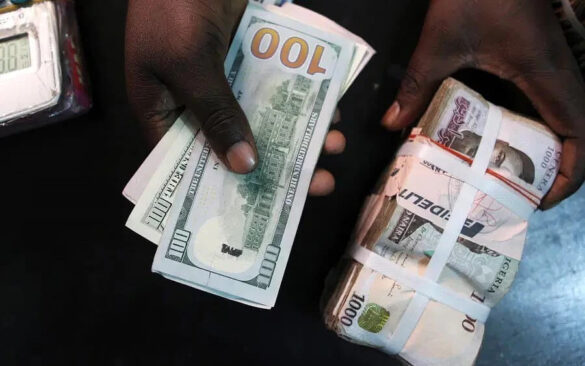Nigeria’s foreign exchange market is experiencing a rare moment of calm, as easing dollar demand helps the naira hold steady against major currencies.
After months of sharp swings and relentless decline, the currency has traded within a relatively tight band in recent weeks, a development analysts credit to a mix of tighter monetary policy, rising foreign inflows, and a more cautious approach to imports by businesses.
At the Nigerian Autonomous Foreign Exchange (NAFEX) window, the naira has traded between N1,480 and N1,520 per dollar over the past two weeks, a marked shift from the volatility of early 2025. The parallel market has also stabilized, narrowing the gap between official and street rates and restoring some confidence among investors and importers.
CBN’s Policy Drive Behind the Calm
Economists say the Central Bank of Nigeria (CBN) deserves much of the credit. The regulator has raised the benchmark interest rate to 28 percent — a move aimed at discouraging speculative dollar demand by making naira-based assets more attractive.
In addition, the CBN has stepped up supervision of banks’ foreign currency positions and resumed targeted dollar sales to meet priority needs.
“These measures have brought discipline back into the market,” said Adewale Omotosho, head of treasury at a Lagos investment firm. “Liquidity has been squeezed, loopholes have been blocked, and panic buying of dollars has eased significantly.”
Complementary efforts by the federal government have reinforced the gains. Increased crude oil production — now averaging 1.6 million barrels per day — and firmer global oil prices have boosted export receipts, nudging external reserves to about $36.5 billion.
Foreign Inflows Picking Up
Foreign portfolio investors, who fled during the peak of naira instability, are slowly returning. Higher yields on government bonds and a belief that the worst of the crisis has passed have brought back over $1.2 billion in fresh inflows in August alone.
“There is a growing sense that the naira has found its footing,” said Chika Okoye, an economist with a multinational bank. “Even small inflows tilt the market balance when demand is subdued.”
Remittances from the diaspora have also risen by 8 percent year-on-year, thanks to reforms allowing beneficiaries to receive payments in dollars. This has further strengthened the supply side of the market.
Foreign direct investment, though still cautious, is showing early signs of life, with several energy and infrastructure projects restarting after months of delay.
Cooling Demand Helps Stabilize FX
Demand-side pressures are also easing. Many businesses have scaled back import orders as higher exchange rates and tighter credit squeeze profit margins.
Manufacturers are increasingly sourcing local raw materials, while luxury importers have deferred purchases.
Consumers, facing costlier foreign travel, education, and medical expenses, are spending more conservatively. Travel agencies report outbound bookings down about 15 percent compared with last year.
Banks, too, are seeing fewer dollar loan requests, and have tightened access to letters of credit to ensure FX is used for viable, well-hedged projects.
Fragile Gains — Analysts Urge Vigilance
Despite the respite, analysts warn that naira stability is not yet guaranteed. The country’s heavy dependence on oil revenues leaves it exposed to external shocks, while sustained high interest rates risk hurting growth and employment.
“Policy discipline must continue,” said Moyo Adeniran, a senior economist at a Lagos think tank. “Without diversifying exports and reducing import dependence, this stability could easily unravel.”
Global risks, including a stronger U.S. dollar also loom, as higher U.S. interest rates could trigger capital outflows and raise debt servicing costs.
Outlook: Cautious Optimism
For now, traders expect the naira to maintain its current range, helped by the approaching harvest season — which could trim food imports — and increased domestic fuel output as the Dangote refinery ramps up operations.
If inflation keeps trending lower and reserves continue to rise, the CBN may slow the pace of rate hikes, though it is unlikely to reverse its tightening stance soon.
“The goal is to maintain confidence without strangling growth,” Okoye said. “If that balance is struck, the naira could even strengthen toward ₦1,400/$ by year-end.”
Business sentiment is gradually improving. The Lagos Chamber of Commerce reports a slight rise in its confidence index, while the stock market has seen renewed foreign interest, especially in banking and consumer goods stocks.
For ordinary Nigerians, the steadier naira is offering some relief from runaway price increases, though inflation remains high.
Experts caution that only deeper structural reforms, including export diversification, infrastructure upgrades, and improved security, can turn this temporary calm into lasting stability.
Leadership
See also:
Obi’s Credibility Can Deliver 40% Votes For PDP – Dan Ulasi
Ondo Attorney General Hails Agboola Ajayi For Withdrawing Supreme Court Appeal
Nigeria Must Double Growth Pace, Strengthen Naira To Meet $1tn Economy Target – Economy
Fire Disrupts Business On Broad Street As Nine Rescued, Five Revived





